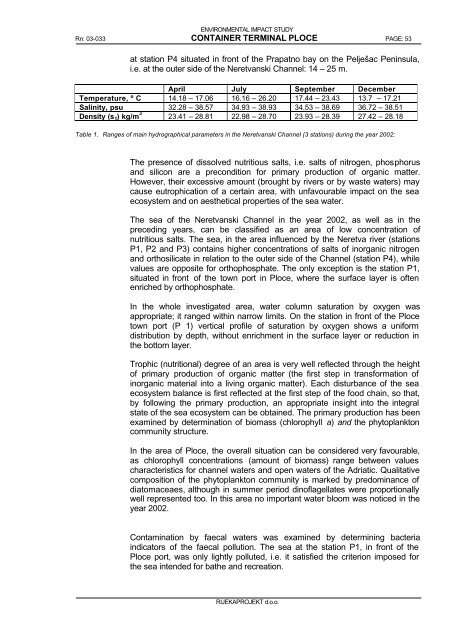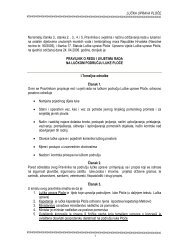HEADING PAGE - port of ploce authority * welcome
HEADING PAGE - port of ploce authority * welcome
HEADING PAGE - port of ploce authority * welcome
You also want an ePaper? Increase the reach of your titles
YUMPU automatically turns print PDFs into web optimized ePapers that Google loves.
ENVIRONMENTAL IMPACT STUDY<br />
Rn: 03-033 CONTAINER TERMINAL PLOCE <strong>PAGE</strong>: 53<br />
at station P4 situated in front <strong>of</strong> the Prapatno bay on the Pelješac Peninsula,<br />
i.e. at the outer side <strong>of</strong> the Neretvanski Channel: 14 – 25 m.<br />
April July September December<br />
Temperature, º C 14.18 – 17.06 16.16 – 26.20 17.44 – 23.43 13.7 – 17.21<br />
Salinity, psu 32.28 – 38.57 34.93 – 38.93 34.53 – 38.69 36.72 – 38.51<br />
Density (s t) kg/m 3 23.41 – 28.81 22.98 – 28.70 23.93 – 28.39 27.42 – 28.18<br />
Table 1. Ranges <strong>of</strong> main hydrographical parameters in the Neretvanski Channel (3 stations) during the year 2002:<br />
The presence <strong>of</strong> dissolved nutritious salts, i.e. salts <strong>of</strong> nitrogen, phosphorus<br />
and silicon are a precondition for primary production <strong>of</strong> organic matter.<br />
However, their excessive amount (brought by rivers or by waste waters) may<br />
cause eutrophication <strong>of</strong> a certain area, with unfavourable impact on the sea<br />
ecosystem and on aesthetical properties <strong>of</strong> the sea water.<br />
The sea <strong>of</strong> the Neretvanski Channel in the year 2002, as well as in the<br />
preceding years, can be classified as an area <strong>of</strong> low concentration <strong>of</strong><br />
nutritious salts. The sea, in the area influenced by the Neretva river (stations<br />
P1, P2 and P3) contains higher concentrations <strong>of</strong> salts <strong>of</strong> inorganic nitrogen<br />
and orthosilicate in relation to the outer side <strong>of</strong> the Channel (station P4), while<br />
values are opposite for orthophosphate. The only exception is the station P1,<br />
situated in front <strong>of</strong> the town <strong>port</strong> in Ploce, where the surface layer is <strong>of</strong>ten<br />
enriched by orthophosphate.<br />
In the whole investigated area, water column saturation by oxygen was<br />
appropriate; it ranged within narrow limits. On the station in front <strong>of</strong> the Ploce<br />
town <strong>port</strong> (P 1) vertical pr<strong>of</strong>ile <strong>of</strong> saturation by oxygen shows a uniform<br />
distribution by depth, without enrichment in the surface layer or reduction in<br />
the bottom layer.<br />
Trophic (nutritional) degree <strong>of</strong> an area is very well reflected through the height<br />
<strong>of</strong> primary production <strong>of</strong> organic matter (the first step in transformation <strong>of</strong><br />
inorganic material into a living organic matter). Each disturbance <strong>of</strong> the sea<br />
ecosystem balance is first reflected at the first step <strong>of</strong> the food chain, so that,<br />
by following the primary production, an appropriate insight into the integral<br />
state <strong>of</strong> the sea ecosystem can be obtained. The primary production has been<br />
examined by determination <strong>of</strong> biomass (chlorophyll a) and the phytoplankton<br />
community structure.<br />
In the area <strong>of</strong> Ploce, the overall situation can be considered very favourable,<br />
as chlorophyll concentrations (amount <strong>of</strong> biomass) range between values<br />
characteristics for channel waters and open waters <strong>of</strong> the Adriatic. Qualitative<br />
composition <strong>of</strong> the phytoplankton community is marked by predominance <strong>of</strong><br />
diatomaceaes, although in summer period din<strong>of</strong>lagellates were pro<strong>port</strong>ionally<br />
well represented too. In this area no im<strong>port</strong>ant water bloom was noticed in the<br />
year 2002.<br />
Contamination by faecal waters was examined by determining bacteria<br />
indicators <strong>of</strong> the faecal pollution. The sea at the station P1, in front <strong>of</strong> the<br />
Ploce <strong>port</strong>, was only lightly polluted, i.e. it satisfied the criterion imposed for<br />
the sea intended for bathe and recreation.<br />
RIJEKAPROJEKT d.o.o.



